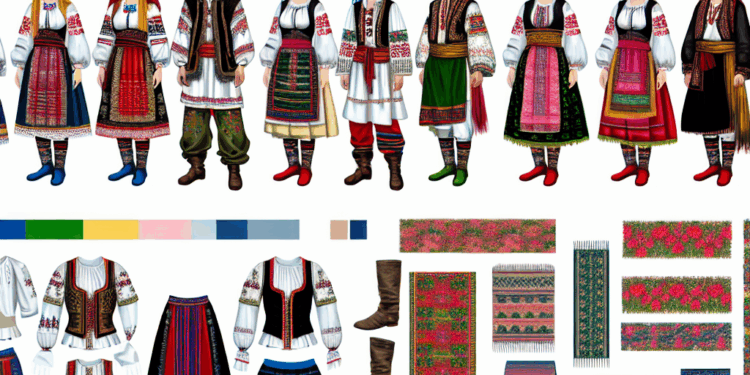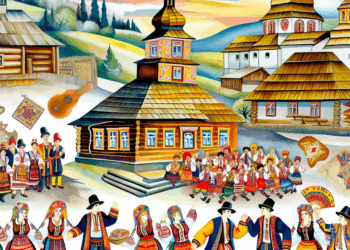Introduction
Bukovyna, a picturesque region in the northwest of the Chernivtsi region of Ukraine, has long attracted the attention of researchers with its diverse culture and rich heritage. Combining elements of Ukrainian, Romanian, Jewish and Polish cultures, this region has become a unique example of multinational coexistence. The study of traditions, folk costumes, crafts, festivals, music and folklore of Bukovyna allows us to better understand its special place in the cultural mosaic of Eastern Europe.
Historical context
Bukovina has repeatedly changed hands between different powers during its history, from the Habsburg Monarchy to the Soviet Union. This brought a diversity of ethnic groups and traditions to the region. In the nineteenth century, Bukovina became part of Austria-Hungary, which contributed to the significant growth of Polish and Jewish cultures, while Ukrainian and Romanian traditions maintained their identity and filled the cultural landscape.
Traditions
Minimal, but with soul: rites and rituals
The traditions of Bukovina have been formed over the centuries and are permeated with elements of all ethnic groups that lived here. This is reflected in the rituals related to the life cycle of a person: birth, wedding, funeral. For example, weddings in Bukovina are large-scale events filled with music, dancing, and lavish treats. Each village has its own unique rituals, which often have pagan roots.
Folk costumes
Folk costumes in Bukovina are not just clothes, but colourful symbols of local identity. Craftsmen sewed them using brightly coloured fabrics and intricate embroidery. Women’s costumes are usually decorated with colourful ornaments and embroidery, while men’s costumes are characterised by simplicity, but also have their own unique elements. For example, embroidered shirts, shawls and belts, which represent family and cultural traditions, are characteristic of the region.
Crafts
The art of light industry
Handicrafts such as weaving, embroidery and woodwork are actively developed in Bukovina. Such skills are passed on from generation to generation. Craftsmen, especially in cities such as Chernivtsi and Kitsman, are famous for their fabrics and embroideries. The famous carpet craft, using bright colours and intricate patterns, has become a trademark of the region.
Pottery craftsmanship
Another important aspect of crafts in Bukovina is pottery. Potters create unique ceramics, which are characterised not only by their functionality, but also by their aesthetic value. Decorative elements and handmade pots are often the pride of the locals.
Holidays
Summer Folk Art Festival
One of the brightest events in the cultural calendar of Bukovyna is the Summer Folk Festival, which takes place in Chernivtsi. This multicultural festival brings together representatives of different ethnic groups who demonstrate their traditions through music, dance and craft exhibitions.
Christmas festivities
Christmas in Bukovina is celebrated in a special way, and every year the regions organise colourful festivals with carols and chiddrivki, while the inhabitants sing spiritual songs and prepare traditional dishes. In time for Holy Evening, tables are decorated with Lenten dishes and biscuits, and families come together to spend this special evening with loved ones.
Music and folklore
Sounds of tradition: instruments and performers
The music of Bukovina is diverse and multifaceted, with influences from Ukrainian, Romanian and Jewish musical traditions. Instruments such as dulcimers, violins and tambourines play an important role in the region’s musical heritage. Using traditional melodies and rhythms, musicians create unique works that reflect the spirit of the region.
Folklore groups
In recent years, folklore groups that explore and preserve local traditions have been actively developing in Bukovina. They perform at all holidays and festivals, adapting ancient songs for modern audiences. One such group is Bukovyna Sich, which popularises folk music and Carpathian folklore.
Multinational heritage
Ukrainian influence
Ukrainian culture in Bukovina is represented by language, folklore, folk customs and traditions. The locals preserve their customs, pass them on from generation to generation and actively participate in cultural events.
Romanian and Jewish heritage
Romanian culture, as an important component of the region, is manifested through language and traditions, such as the celebration of “Romanian Independence Day” or Christmas rituals. Jewish culture, in turn, has left its mark in architecture and music. The streets of Chernivtsi still preserve the memory of Jewish intellectuals and musicians who made a significant contribution to the development of cultural life.
Polish influence
The Polish community in Bukovina has also left an important mark on the cultural heritage of the region. The architecture of Polish manors and churches, as well as the traditions of celebrating fairs and other events, wrap the cultural context of Bukovina, creating a unique ensemble.
Conclusion
The culture of Bukovina is a colourful and diverse kaleidoscope of traditions, music, festivals and crafts, where each ethnic minority finds its place and contributes to the creation of a unified cultural mosaic. This emphasises the importance of the region’s multicultural heritage and the need to preserve it. Understanding and respecting the culture of Bukovina will open new horizons for further research, cultural exchanges and interactions at the level of both local communities and global culture. This region is a true monument of diversity and identity, standing at the crossroads of different histories and cultural traditions.








